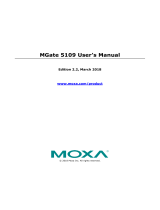
time the device buffers events before sending them out, after occurrence of an event.
These parameters are useful for controlling the flow of events from the device and
combining them into bigger reports.
Legacy master UR provides compatibility to some older DNP3 clients. When set to
disabled, the server follows the DNP3 standard, sending its first unsolicited message
after a connection has been established following relay reboot. The client is expected
to send the Enable/Disable Unsolicited messages command to the relay. When Legacy
master UR is enabled, the relay does not send the initial unsolicited message.
Unsolicited responses are sent without the need of the Enable Unsolicited command.
The client still needs to open a connection for the server to start sending unsolicited
messages.
Unsolicited reporting mode is not recommended in half-duplex (RS-485 2-wire mode
or optical ST mode) serial bus due to possibility of collisions in the serial bus.
Especially in a system where event reporting is frequent, collisions can cause failed
DNP3 requests/responses and thus retransmissions. If unsolicited mode is used,
application level confirmations should be enabled to ensure that transmission is
successful. In half-duplex serial bus, polled mode is recommended.
3.3.5 Communication supervision and diagnostics
3.3.5.1 Communication supervision status
The DNP3 protocol provides a link to a keep-alive mechanism which can be used in
both Ethernet (TCP/IP) and serial communication modes. When the client has
successfully established connection to the protection relay, keep-alive messages are
sent periodically by the client or protection relay, depending on which one has a lower
keep-alive interval setting. Keep-alive timer is also restarted by any normal DNP3
frame, so keep-alive messages are only being transmitted after a longer idle time
between frames. In the protection relay, the keep-alive timeout can be set with the Link
keep-alive (seconds) parameter.
Default value “0” means that no keep-alive messages are sent by the protection relay.
Keep-alive requests sent by the client are still responded to. If a keep-alive message is
not responded to, the connection is considered broken. In case of TCP/IP connection
the protection relay closes the associated TCP socket connection, and a new
connection must be initiated by the client.
The DNP3 link status (True/False) is updated in the Monitoring data Status, which
also can be also used in Application Configuration tool in PCM600 for additional
logic connection, for example, to a LED. DNP3 link status exists separately for each
DNP3 protocol instance. True (value 1) means that the connection is active. False
(value 0) means the connection has timed out. The status can be found via
Monitoring/Communication/DNP3.0/DNP3.0n/Status.
On Application Configuration tool level, the DNP3 protocol instance is represented
by a function block DNPLPRTn, where n is the protocol instance number 1…5.
Section 3 1MRS758757 A
Vendor-specific implementation
14 REC615 and RER615
Communication Protocol Manual





















